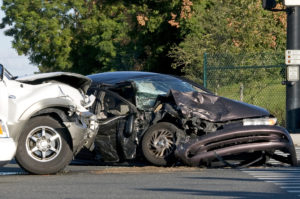what is the leading contributor to tbi cases in the united states?
Did you know that one person in the United states of America sustains a encephalon injury every 23 seconds? (Source) Around 50,000 of these individuals volition die annually following a Traumatic Brain Injury (TBI). Adolescents, young adults, and the elderly are at the highest risk of sustaining this injury (Source).
While car accidents contribute about 14% of the aggregate TBI cases in the US, they are the leading cause of TBI-related deaths amidst children and immature adults (Source). Thus, more attention needs to exist focused on automobile accidents.
Nosotros took some time to get together the latest car accidents and brain injury statistics to testify how bad the TBI problem is in the United states, who is at the highest risk, the leading causes, the contribution fabricated past car accidents to the problem, and the cost of such injuries to social club and individuals.
1 thing that is clear from the data available is that automobile accident and TBI statistics are not updated every year. Thus, we have gathered the latest available numbers to go an idea of the general state of affairs prevailing.
What is a Traumatic Brain Injury?
A Traumatic Brain Injury (TBI) is defined by the National Institute of Neurological Disorders and Stroke as an injury that can be "caused past a forceful bump, blow, or jolt to the head or body, or from an object that pierces the skull and enters the brain." Even so, the same organization notes that it is not all jolts or blows that effect in a TBI (Source).
The injury that happens at the time of impact is called the main injury. Master injuries could affect the entire brain or a specific role of it. Due to the bear upon caused by an blow, the encephalon can crash into the sides of the skull leading to haemorrhage, bruising, or slitting of the nerve fibers.
Following the commencement impact, the encephalon could go through what is known equally delayed trauma. At this stage, known as the secondary injury, the brain swells and pushes against the skull. This tin can issue in a reduction in oxygen flow effectually the encephalon. Thus, a secondary injury can exist more than dissentious than the outset 1.
Classifying TBIs
In terms of severity, TBIs can be classified into two broad categories:
A Mild TBI: The individual is usually awake. The symptoms may include a brief loss of consciousness, defoliation, headache, disorientation, and memory loss.
A Astringent TBI: There is a loss of consciousness for several hours, or even weeks, and could event in permanent disability.
The National Institute of Health (NIH), names two types of TBIs:
A Penetrating TBI: Also referred to equally an open TBI, occurs when an object, such as a bullet, shrapnel, or pocketknife, pierces the skull and enters the brain tissue. This blazon of injury ordinarily damages a function of the brain.
A Non-penetrating TBI: This is sometimes called a blunt TBI. It occurs when an external force is strong enough to move the encephalon within the skull. Examples include sports injuries, auto accidents, falls, or when an object strikes the caput.
Why is TBI Data Critical?
Why practise we need to be concerned about car accidents and brain injury statistics? Data plays a vital role in understanding the impact of machine accidents and traumatic brain injuries every bit health challenges.
When nosotros take data, it becomes easier to determine the causes, develop prevention strategies, decide in terms of inquiry and pedagogy strategies, and learn know-how so we tin can assist those affected and impacted by a TBI.
Another reason why information technology is vital to assemble auto accidents and TBI information is that its impact can be felt many years subsequently the incident. Having the right information about the extended effects can ensure that victims from the motorcar accidents, which atomic number 82 to a TBI, get the justice and compensation they deserve, even if they are passengers, pedestrians, or cyclists.
Brain Injury Statistics at a Glance
To provide a glimpse of the U.s.a.'s TBI state of affairs, beneath are some quick statistics provided by the Brain Injury Alliance of Utah. This non-profit organization provides support and education on matters linked to the prevention and recovery of brain injury (Source):
- Effectually 1.seven million Americans sustain a TBI every year.
- Most one,365,000 Americans are treated for a TBI and released from an emergency department annually.
- An estimated 5.iv million people in the Usa alive with disabilities associated with a TBI.
- Without back up, 75% of persons in the US with a TBI lose their jobs within 90 days of returning to work.
- The lifetime cost for each severe TBI survivor is estimated to exist more than $4 million.
- Machine accidents, falls, and violence are the most mutual causes of traumatic brain injury.
- About eighty% of all TBI cases are categorized as a balmy TBI (Source).
Prevalence in the United states of america
The latest reliable statistics on the prevalence of TBIs provided by the Centers for Disease Control and Prevention (CDC) are from 2014. These figures show that 837,000 incidents involved children (aged 17 or younger). In the same year, traumatic brain injuries resulted in the death of 56,800 people.
Notwithstanding the statistics provided by the CDC higher up, an commodity written by Kyle C. Dennis, Ph.D. for the American Spoken communication-Language-Hearing Association says the numbers should be taken with circumspection. Dennis argues that "there is an ongoing debate over the nature of mild traumatic brain injuries, its diagnosis (or rather it's over diagnosis), its pathophysiology, its natural history, and fifty-fifty the terminology to describe the condition" (Source).
Dennis says that several authors accept argued that a balmy traumatic brain injury is often used to describe whatever cases of unresolved brain injury (Source). For this reason, the numbers may not reflect the bodily situation on the footing.
Prevalence Globally
An article published in 2018 by the National Center for Biotechnology Information's National Library of Medicine reports that 69 million individuals suffer a TBI each year globally. The same article, entitled Estimating the Global Incidence of Traumatic Encephalon Injury, reports that "the proportion of TBIs resulting from route traffic collisions was the greatest in Africa and Southeast Asia (both 56%) and the everyman in North America (25%)."
The American Speech-Language-Hearing Association notes that many of the mild TBI cases are treated exterior the hospital or not treated at all. These figures are not captured in all interpretation data; hence, this health problem could be nether-estimated (Source).
Higher TBI Incidences among the Homeless
A Academy of British Columbia 2019 study focused on 38 studies published between 1995 and 2018 and found that "people who are homeless feel a disproportionately high lifetime prevalence of traumatic brain injury (TBI)." The aforementioned article reports that ane in every two homeless persons feel a TBI. It also reports that one in every iv homeless persons experiences a moderate to severe TBI.

The aforementioned British Columbia study found that the lifetime prevalence of moderate and severe traumatic brain injuries among homeless people could be ten times higher than that of the statistics of the general population (Source).
Leading Causes of TBI
Falls are the leading cause of traumatic encephalon injuries in the United states of america. They are mainly responsible for the majority of traumatic brain injuries amidst infants, children, and the elderly (Source).
Being struck by, or hitting confronting an object, is responsible for ane in every v TBI-related injuries in children under fifteen years old. This includes being hit unintentionally past a person or an object, including falling debris (Source).
Car accidents are the leading cause of TBI-related deaths of children and young adults between the ages of v-24 (Source).
Source: Encephalon Injury Alliance of Connecticut
Fiscal Costs of TBIs
The costs of a TBI include primary medical intendance (hospitalization, ambulance transportation service, and emergency room intendance), lost income and wages (if the patient is unable to work for some time, rendered disabled, or unemployable), and recovery from injury (physical and cognitive rehabilitation).
When information technology comes to a TBI's total cost, hospital bills solitary do not provide a total motion picture. For instance, a patient could require therapy, vocational training, medication, legal representation, and adaptive strategies to recover from the effects of a TBI.
Co-ordinate to the American Association for the Surgery of Trauma (AAST), around i.2 million people die from road accidents every year beyond the earth. The AAST describes itself equally an organization "defended to the discovery, dissemination, implementation, and evaluation of knowledge related to acute care surgery (trauma, critical surgical care, and general emergency surgery) by fostering enquiry, teaching, and professional development in an environment of fellowship and collegiality."
The AAST reports that the estimated almanac cost of the five or and then one thousand thousand people living with inability from a TBI on the US is around $37.viii billion. The aforementioned organisation estimates the global annual cost to be virtually $518 billion globally (Source).
Costs to the Individual
While attention is frequently paid to the fiscal costs of car injuries and traumatic encephalon injuries, the costs to affected individuals could easily exist overlooked. The Family Caregiver Alliance provides an idea of some of the costs of traumatic encephalon injuries to the affected individual:
- Retentiveness challenges, especially short term memory.
- Difficulties with solving problems, following instructions, and the ability to learn new material, or understand abstruse concepts.
- Poor judgment.
- Partial, or consummate loss, of the ability to read and write, and the ability to communicate.
- Problems with muscle co-ordination, including swallowing.
- Changes in sexual functioning.
- Sleep challenges and seizures.
- The disability to empathise with others, challenges with social skills, and a leaning towards being self-centered, exhibiting aggressive behavior, being hands angered, and dramatic mood swings.
- A loftier risk of depression.
Gender Comparison
Males are 1.v times more likely to sustain a TBI than females, and three times more than likely to die from its furnishings (Source). This college incidence of traumatic encephalon injuries among males is especially higher during young adulthood (Source).
But why are males i.5 times more than likely to sustain a TBI when compared to women? According to the Encephalon Injury Association of America, "the jobs and workplaces of men are associated with more severe injuries." The same arrangement also says that females are more than likely to report their injuries than males.
Deaths and Permanent Disabilities
According to the CDC, every year in the U.s.a., almost 50,000 people dice from TBI-related cases. Around 80,000 to 90,000 people become long-term disability as a event of a TBI annually. The yearly 50,000 deaths by brain injury are a third of all deaths caused by whatsoever form of trauma (Source).
It is estimated that 5.3 1000000 people are living with a permanent inability in the United States, every bit a effect of a TBI-related incident (Source). Around 13.v 1000000 Americans live with the second most prevalent disability, known as the acquired brain trauma (Source).
TBIs Due to Car Accidents
Co-ordinate to the CDC, in 2014 "motor vehicle crashes were the leading crusade of expiry for persons aged fifteen-24, 25-34, and older adults aged ≥75 years" (Source).
Specifically, an estimated 200,000 injuries every year result from traffic accidents. Included in this number are accidents that involve pedestrians, trains, and bicycles (Source).
What makes a TBI resulting from car crashes complicated is that it tin can occur fifty-fifty if an private has non experienced a direct impact. How is this possible? The physical force emanating from a standoff can motion the brain without the head bumping onto anything. This is why individuals involved in a automobile crash always need to be checked past a doctor following the incident.
A Promising Future
According to the CDC, since 1980, the rate of TBI-linked decease resulting from transportation crashes has declined. The numbers are reported to accept gone downwards by about forty% since 1980 (Source).
The CDI speculates that several factors can be attributed to this decrease. Some of these include "an increase in wearing a seat belt and child safety seat employ, an increase in the number of vehicles equipped with airbags, and a decrease in the incidence of driving while intoxicated." The CDC adds, "These positive changes should receive continued support" (Source).
Source: https://www.augerlaw.com/blog/car-accidents-and-brain-injury-statistics-2020/
0 Response to "what is the leading contributor to tbi cases in the united states?"
Post a Comment